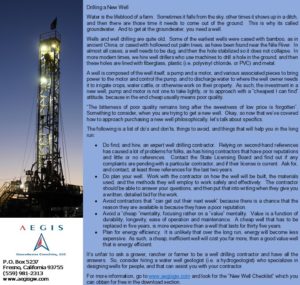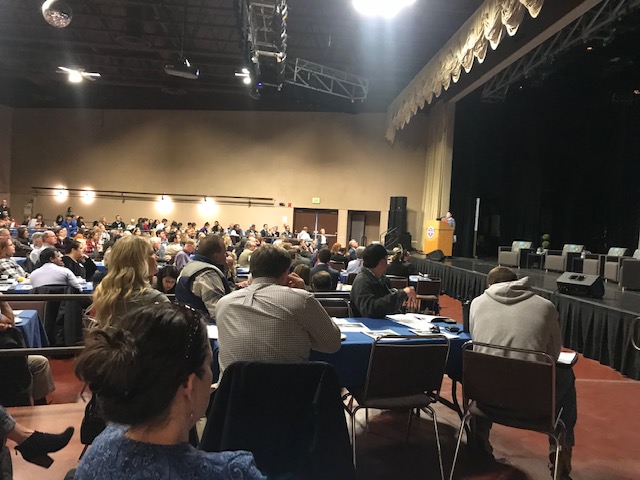 The Public Policy Institute of California held a seminar on Friday, February 22, 2019 at California State University Fresno’s Satellite Student Union. “Water and the Future of the San Joaquin Valley” was the title of the day’s event. This is also the title of the report prepared by PPIC and FSU. Things kicked off at 8:30am with delicious sausage, egg and cheese English muffin sandwiches and fresh pastries with coffee and orange juice. Why even mention this? I go to a lot of meetings and I notice when folks start with a decent breakfast the day really does go better. PPIC has a reputation for staging pretty good shows and starting with good food really tied the “ag thing” together. They did something right because the room was packed with folks standing in the aisles. There were more than 300 people is my guess.
The Public Policy Institute of California held a seminar on Friday, February 22, 2019 at California State University Fresno’s Satellite Student Union. “Water and the Future of the San Joaquin Valley” was the title of the day’s event. This is also the title of the report prepared by PPIC and FSU. Things kicked off at 8:30am with delicious sausage, egg and cheese English muffin sandwiches and fresh pastries with coffee and orange juice. Why even mention this? I go to a lot of meetings and I notice when folks start with a decent breakfast the day really does go better. PPIC has a reputation for staging pretty good shows and starting with good food really tied the “ag thing” together. They did something right because the room was packed with folks standing in the aisles. There were more than 300 people is my guess.
Fresno State University Vice President and Provost Dr. Robert Harper greeted folks at 9:00am along with Michael Frantz, co-owner of Frantz Wholesale Nursery. The ball got rolling with PPIC’s Water Policy Director Ellen Hanak. She said, “The solution is not simple but the math is.” Finding water at a price farmers can afford is the answer to our water deficit problem. The further south one goes in the Central Valley the more overdrafted the aquifer becomes for the most part. The Valley also has air and water quality challenges unique to the location. Salts and nitrates are the biggest water quality problems. If I understood correctly the Valley uses about 16.7 million a/f per year for agriculture supplies. She said while irrigation efficiency is good it won’t be enough. Less thirsty crops and fallowing land will be necessary.
Hanak gave suggestions on how to handle the water deficit; Inflexible water use is expensive and local water trading cuts costs and Valley-wide water trades will reduce the costs further. This can save land from fallowing as well. Additionally:
- More incentive for recharging farmland,
- develop local trading rules,
- clarify how much water is available for recharge,
- facilitate approvals for trading and banking projects,
- coordinate to maximize benefits
Water quality was next. Salts and nitrates are the big two but that will be discussed further later in the program. Hanak said there are 2.8 million acres of farmland suitable for recharge. Almonds and pistachios are the orchard crops with the best results. Of course this depends on soil types and water supplies. Citrus isn’t considered a good on-farm recharge crop. But there is still more than half a million acres that will need to be taken out of production. This land can be used for solar power sites, San Joaquin desert, riparian corridors/floodplain and intermittent wetlands like the Kern Water Bank make up 22 percent of the fallowed or retired lands. The other 68 percent is expected to sit idle. Not such good news. But there is hope that flexible water policies and smarter, better regulatory actions hold out the possibility of weathering this storm.
Balancing Supply and Demand
The first panel was about balancing supply and demand. Alvar Escriva-Bou, research fellow with PPIC moderated  Eric Averett – GM Rosedale Riot Bravo Water Storage District, Kiti Campbell – Westlands Water District, Thomas Esqueda – VP of Water FSU and Ric Ortega – GM Grasslands WD in a discussion.
Eric Averett – GM Rosedale Riot Bravo Water Storage District, Kiti Campbell – Westlands Water District, Thomas Esqueda – VP of Water FSU and Ric Ortega – GM Grasslands WD in a discussion.
Campbell went first saying WWD has developed a groundwater model based on more than 50-years of recorded data. She also said Westlands has metered its wells and she encouraged others to do so. This brings to mind a statement by water attorney Lauren Layne who said those with the best data will end up wining should matter go to court.
Averett said RRB has been working on balancing its surface and groundwater storage. He said his board told him his job consists of turning two knobs: the augmenting supplies and reducing demand. He’s only allowed to turn the first knob. He said the strategy is to fallow several small parcels throughout the district, take the money that would have been spent on those parcels to purchase land without the demand and start banking water. Campbells said WWD’s clay layer requires injection below the Corcoran clay. This would be metered and credited to the landowners for later use.
Esqueda was asked about land management. He said for municipalities to be careful of the way their water infrastructure is designed and implemented is ever more important. Thinking about demand management is a community effort. Esqueda is the former Public Utilities Director for the City of Fresno. He said Fresno has reduced waste by more than 40-percent but DWR and the state will be demanding more. He said engaging the community is very important. During the recent drought water agencies sold less water and found themselves in financial problems. Instead of having a 218 Election shot down in flames it is much better to start the dialog up front.
Ortega was asked how managing water for the environment is different than urban or ag. He said measuring and analyzing data is needed to feed the support system. Keep as current as possible has realized growing benefits. It has yielded  some simple results. Putting up a berm can keep ag tail water recharging and not flowing in unwanted areas. He said the wetlands looks very natural but it is intensely managed. He is always considering how to grow more feed for the birds of the Pacific Flyway.
some simple results. Putting up a berm can keep ag tail water recharging and not flowing in unwanted areas. He said the wetlands looks very natural but it is intensely managed. He is always considering how to grow more feed for the birds of the Pacific Flyway.
Escriva-Boa asked the panel how to get more cooperation between urban and ag. Esqueda said for generations the two entities have coexisted by leaving each other alone. SGMA changed that. He said the City of Fresno and Fresno ID got together in a room and asked each other what successful implementation of their needs would look like. The obstacle is to communicate well. There has to be mutual benefits for the constituents to buy-in. Ortega said much the same thing – both sides have to find a reason to work together to each-other’s wellbeing. He said no one likes new regulatory hammers but they do force  partnerships. Averett said at the height of the drought folks in his district had to move out of their homes because domestic wells have gone dry. Now if that looks like banking recovery is the culprit there are remedies in place. He reminded everyone there is a glide path under SGMA to get basins into balance.
partnerships. Averett said at the height of the drought folks in his district had to move out of their homes because domestic wells have gone dry. Now if that looks like banking recovery is the culprit there are remedies in place. He reminded everyone there is a glide path under SGMA to get basins into balance.
The panel was asked for their thoughts on what needs to be done. Campbell said WWD’s biggest priority is to bring as many projects into the west side sub basin to lessen the impact. Esqueda said the need is for the urban sector to continue cooperation with others in developing infrastructure that benefits the entire Valley. Ortega said working through pilot projects that can further good management. He said pilots sometimes fail but they all teach lessons worth learning. He said eat a whale one bite at a time. Averett said breaking down good water management barriers is a priority. He has a canal moving water into a recharge basin with a pump just a few yards away pumping water into the canal. That doesn’t make sense.
The audience was invited to ask questions. Averett said his district is looking to develop a groundwater account just like  a surface water account. Campbell said WWD has proposed a groundwater pumping allocation that is universal based on acreage and that will even the playing field. Averett said keeping it equal for all is important to keeping it fair. Averett also said RRB has an agreement with surrounding landowners in white lands for rights of first refusal. A supply may not be fiscally attractive to his growers but would be to the white lands. Esqueda said getting infrastructure that can convey water to un-districted lands is going to become more important. Some asked how much water flowing through the Delta to the ocean could have been ag water. There’s more than 200,000 cfs going out to sea currently with the Delta pumps operating under capacity at less than 20,000 cfs. Not even 10 percent. Averett said a series of big gulps and sips – bringing new infrastructure, regulatory relief and better political action.
a surface water account. Campbell said WWD has proposed a groundwater pumping allocation that is universal based on acreage and that will even the playing field. Averett said keeping it equal for all is important to keeping it fair. Averett also said RRB has an agreement with surrounding landowners in white lands for rights of first refusal. A supply may not be fiscally attractive to his growers but would be to the white lands. Esqueda said getting infrastructure that can convey water to un-districted lands is going to become more important. Some asked how much water flowing through the Delta to the ocean could have been ag water. There’s more than 200,000 cfs going out to sea currently with the Delta pumps operating under capacity at less than 20,000 cfs. Not even 10 percent. Averett said a series of big gulps and sips – bringing new infrastructure, regulatory relief and better political action.
Managing for Water Supply & Quality
This panel was moderated by FSU’s Sarge Green, who was instrumental in working with the PPIC. The panel was: David Cory – farmer and water attorney who follows the Regional Board and Bay/Delta matters, Helen Dahlke – professor of hydrology UC Davis, Veronica Garibay – NGO Leadership Council for Justice & Accountability and Anja Raudabaugh – CEO Western United Dairymen.
Garibay was asked what the next step is to get safe drinking water to the Valley. She said more than one million Californians don’t have clean drinking water as we sit here. She said disadvantaged communities have a penalty. Many DC’s pay $50 per month for water they can’t drink. There is an effort to provide a state fund to help finance the remediation.
Cory was asked about CV Salts. He said CV Salts has been up and running for more than 10-years. He said many meetings later a salt balance became a salt balance and a nitrate balance problem. He said it is a big problem and needs to be addressed. He said old policies morphed into bad regulation and it could have wiped out ag. Fertilization and irrigation couldn’t meet the regulatory thresholds. A compromise has been proposed to step and help solve the drinking water problem in exchange for regulatory flexibility. He said for the first time in his experience ag has been asking for more regulations that will allow this to come together. He said there are conflicts in supply and quality issues. He said it is best to address this upfront. Less use of water concentrates rather than dilutes constituents.
Raudabaugh was asked what the dairy industry is doing about nitrates. She said the dairy industry has a spot light  shinning on it. There is a challenge of too much manure and the dairy farmers and the communities they work in need certainties. Clean drinking water is a priority for dairy. She sees a much more collaborative effort between ag and regulators. She said there is a logistical problem. Dairy needs to export its manure but there isn’t a demand for it in the Valley. This is being worked on but it won’t happen overnight. Green said this also needs a glide path.
shinning on it. There is a challenge of too much manure and the dairy farmers and the communities they work in need certainties. Clean drinking water is a priority for dairy. She sees a much more collaborative effort between ag and regulators. She said there is a logistical problem. Dairy needs to export its manure but there isn’t a demand for it in the Valley. This is being worked on but it won’t happen overnight. Green said this also needs a glide path.
Dahlke was asked about groundwater quality. She said the nitrate report from Thomas Harter (the UC guy) has identified nitrate in drinking wells got its start 30-years ago in irrigation. She said recharge on crops will be a much bigger amount of water. There was a study on this at Terra Nova Farms in Fresno County. This is Don Cameron’s ranch. She said applying carbon to the soil helps decrease nitrates greatly. Good to know. Soil types cause variance in nitrate transport. She said the microbial systems also play a bigger role than thought. Much studies are needed. Green asked what recharge can take place in a year like this without shooting ourselves in the foot nitrate wise. Dahlke said landowners willing to participate in more pilot programs would be very helpful.
Raudabaugh said her priority is to spread the remediation of drinking water burden to all responsible California with a bond perhaps. Garibay said getting all round input will be helpful – establish the fund. Cory agreed a funding source that everyone pays for since everyone contributes to water quality. He wants the state to be aware there are water quality impacts to water conservation. He said Northern California has good water quality but if irrigation is curbed what are the implications to water quality? He said the state is laboring under outdated policies.
Green asked what the basic elements of the Safe & Affordable Drinking Water Act are. Raudabaugh said there are  some issues but they are working together. Garibay said it isn’t just nitrates; she named several other constituents. Green pointed out ACWA and urban water providers are opposed. He asked the panel what can be done about that. Raudabaugh said this is about safe drinking water and the policy must corroborate with politics. Garibay said this isn’t a new problem and shouldn’t be fixed piecemeal. A source of funding is key.
some issues but they are working together. Garibay said it isn’t just nitrates; she named several other constituents. Green pointed out ACWA and urban water providers are opposed. He asked the panel what can be done about that. Raudabaugh said this is about safe drinking water and the policy must corroborate with politics. Garibay said this isn’t a new problem and shouldn’t be fixed piecemeal. A source of funding is key.
Green asked about long-term O&M as nitrates can be technically address. Dahlke said as long as a groundwater basin can be linked to the ocean there can be a salt and nitrate solution. But, she said the San Joaquin Basin is considered a closed system. Cory said the time to dilute groundwater to safety is decades in the making. He said there was a study that showed if all fertilization were stopped, the groundwater pumped, treated for nitrates and injected it would take more than 50-years to get the nitrates dealt with. Communities can’t wait that long. He said it’s a societal problem and has to be addressed for society.
Questions were next. Someone said chromium six and arsenic can be much worse than nitrogen. Dahlke said hopefully in the coming decades there will be technology available. Cory said the source of nitrogen isn’t a factor to the State and Regional Boards. Cory said environmental justice needs to be looked at globally. He is concerned dairy will be pushed out  of California at the rate we’re going. The nitrates may not be dealt with as well in the new location a they can be here in California. So kicking it down the road to another location won’t be justice of any kind. Green said there are no cases of blue baby syndrome in California because the water quality standards are as high as they are. I had asked if former California EPA Chief Terry Tamminen study that the Los Angeles basin is capable of being completely self sufficient on its average native water supply from precipitation if managed properly. I haven’t heard of any golf courses in LA or San Francisco shutting down from lack of water. This wasn’t addressed. And before you know it was lunch time.
of California at the rate we’re going. The nitrates may not be dealt with as well in the new location a they can be here in California. So kicking it down the road to another location won’t be justice of any kind. Green said there are no cases of blue baby syndrome in California because the water quality standards are as high as they are. I had asked if former California EPA Chief Terry Tamminen study that the Los Angeles basin is capable of being completely self sufficient on its average native water supply from precipitation if managed properly. I haven’t heard of any golf courses in LA or San Francisco shutting down from lack of water. This wasn’t addressed. And before you know it was lunch time.
Lunch
A delicious (I know I already use delicious to describe breakfast but good is good) lunch of one of nature’s two perfect foods, chile verde. Gumbo is the other one.
Valley 2040: Planning for Water and Land Use Transactions
Nathaniel Seavy, Point Blue Conservation Science moderated; Vito Chiesa – Supervisor Stanislaus County, Bernard Jimenez – Fresno County Public Works, Soapy Mulholland – Executive Director Sequoia Riverlands Trust and Jon Reiter – CEO Maricopa Orchards.
Seavy asked about regional planning. Chiesa said sub basin groups (under SGMA) have to work together. When you get past that and county lines its more complex. He said he sees the same issues from more than 10-years ago, they just ramp up in intensity. Jimenez said there has been a great deal of progress in water resource managers and land use planners on the local level. SGMA has to consider planning and planning has to consider SGMA. The issues he deals with in Fresno County are the same as the other Valley counties. They are all going to have to deal with the fall out of SGMA; economic and social as well as water resources. Most of the Valley’s land is under the Williamson Act which adjusts the tax rates on farmland. Fallow land doesn’t qualify and that will be a big game changer. Reiter said taking farmland out of production for say, solar, can often cause a negative alteration of the water rights attached to that land. He naturally sees this as a disincentive. Teaching the landowners how to recharge for the best results will help the Valley take the big gulp when water is available. He sees changing the regulations towards greater flexibility as a much needed tool. Mulholland said her organization endeavors to be a tool to the growers. She said there was a die off of Valley Oaks near Visalia during the drought. As tragic as that was and it was – they are amongst the most majestic trees on earth, it had to be use as a learning experience.
get past that and county lines its more complex. He said he sees the same issues from more than 10-years ago, they just ramp up in intensity. Jimenez said there has been a great deal of progress in water resource managers and land use planners on the local level. SGMA has to consider planning and planning has to consider SGMA. The issues he deals with in Fresno County are the same as the other Valley counties. They are all going to have to deal with the fall out of SGMA; economic and social as well as water resources. Most of the Valley’s land is under the Williamson Act which adjusts the tax rates on farmland. Fallow land doesn’t qualify and that will be a big game changer. Reiter said taking farmland out of production for say, solar, can often cause a negative alteration of the water rights attached to that land. He naturally sees this as a disincentive. Teaching the landowners how to recharge for the best results will help the Valley take the big gulp when water is available. He sees changing the regulations towards greater flexibility as a much needed tool. Mulholland said her organization endeavors to be a tool to the growers. She said there was a die off of Valley Oaks near Visalia during the drought. As tragic as that was and it was – they are amongst the most majestic trees on earth, it had to be use as a learning experience.
Jimenez said the priority will be to relook at the county and city land use plans and get them up to speed with SGMA. He said he knows they are not in compliance. Chiesa agreed with getting the SGMA act together with the general plan and raising funds to improve. Mulholland said to keep pushing for a land retirement program that actually makes sense for California. She doesn’t see piecemeal retirements of parcels. Reiter said more regulatory flexibility is going to be key to pulling all these parts together.
During questions it was asked if getting recharge declared a beneficial use is good and how to deal with the  Metropolitan Water District and other’s opposition. Chiesa said it will be done through stubborn efforts. Reiter said a consideration is to have recharged water be for future use and not horded for future sales. Some gal in the audience groused about no one addressing climate change. Jimenez responded that climate change is now included by law in planning conditions. Mulholland said it is much more on the table now whether it is man made or not. Someone asked how to bridge some of the gaps in SGMA. Reiter said when Maricopa Orchards makes a decision to plant, it doesn’t plant wall to wall and takes into consideration water supplies a decade in advance when the tree matures. He said SGMA will result in fallowed land and the question is how to make that land economically viable. Jimenez said here are forums for water resource managers, planners and other regional collaboration needs. Water is now the biggest topic on the table for regional planning. It is no longer transportation and air quality, though those are still important.
Metropolitan Water District and other’s opposition. Chiesa said it will be done through stubborn efforts. Reiter said a consideration is to have recharged water be for future use and not horded for future sales. Some gal in the audience groused about no one addressing climate change. Jimenez responded that climate change is now included by law in planning conditions. Mulholland said it is much more on the table now whether it is man made or not. Someone asked how to bridge some of the gaps in SGMA. Reiter said when Maricopa Orchards makes a decision to plant, it doesn’t plant wall to wall and takes into consideration water supplies a decade in advance when the tree matures. He said SGMA will result in fallowed land and the question is how to make that land economically viable. Jimenez said here are forums for water resource managers, planners and other regional collaboration needs. Water is now the biggest topic on the table for regional planning. It is no longer transportation and air quality, though those are still important.
Closing
Fresno County grower and poet Mas Masumoto gave the closing remarks saying this is a real matter involving real people. Nature and human nature are involved. He urged everyone to try to be as creative as possible about water. He asked the PPIC folk what songs you think of when you think of water in the Valley. He played “I’m Only Happy When it Rains” by Garbage, “Kern River” by Merle Haggard and “When the Levee Breaks” from Led Zeppelin. “Don’t Go Chasing Waterfalls” also made the list as a warning to not chase fallacies without weighing the consequences. Masumoto’s pick was “Bridge Over Trouble Waters”. He also encouraged us to introduce ourselves as we leave and that was that.
DISCLAIMER OF RESPONSIBILITY; Waterwrights strives to provide his clients with the most complete, up-to-date, and accurate information available. Nevertheless, Waterwrights does not serve as a guarantor of the accuracy or completeness of the information provided, and specifically disclaims any and all responsibility for information that is not accurate, up-to-date, or complete. Waterwrights’ clients therefore rely on the accuracy, completeness and timeliness of information from Waterwrights entirely at their own risk. The opinions expressed in this report are those of the author and do not represent any advertisers or third parties.
ALL RIGHTS RESERVED. Copyright 2019 by Don A. Wright






























